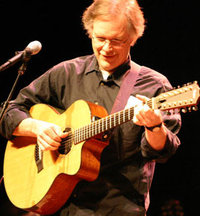
| Home | Tutti A-Z | Testi Italiani A-Z | Testi Stranieri A-Z | Chiedi allo staff |

Leo Kottke
| Gestisci |
|
Received: from mail02.prod.aol.net ([192.203.190.97]) by undergrad.math.uwaterloo.ca with SMTP id :56937-2:; Wed, 6 Jul 1994 22:54:32 -0400 Received: by mail02.prod.aol.net (1.38.193.5/16.2) id AA20677; Wed, 6 Jul 1994 22:54:22 -0400 X-Mailer: America Online Mailer Status: OR Dear Terry, Happily, you've picked an easy Kottke and an especially good one for beginning study. As Leo tellingly reveals on "My Feet Are Smiling", a major portion of his compositional technique is to take "a lovely, simple melody and drive it into the ground." This is his self-effacing way of saying that much of his writing is just theme-and-variations. Nothing ignoble about that. Much of Beethoven's writing could be described the same way, but WHAT themes and WHAT variations (in both cases.) Once you've figured out the gist of a theme in most Kottke tunes, you can work out the variations, or ones of your own, by successively closer and closer approximations (as your skills increase.) The 1st position chord patterns that both 3/4 and 4/4 "North" are based on are among the most-often used in popular music. It could be played C/F/G or D/G/A just as easily, but the version on "Shout Toward Noon" is A/D/E. ("North" itself is a simplified cousin to Mona Roy/Ray.) Begin with an A chord, hammering-on the B string with your 3rd finger and playing the bass on the open A string. Two measures of this, then your melodic transition to the D chord is produced on the B string by hammering-on for five notes (open B,then hammer-down 3rd finger on the 2nd fret,slide it to 3rd fret,2nd fret,3rd fret.) As you finish the fifth hammered note, re-form your other available fingers to complete the D major chord so that you can pluck the other notes of that chord simultaneous to finishing the 5-note hammer-on. Now it's back to the A chord, playing the melody on the hi E and B strings (and the chord for 2 measures.) Forming an E chord with your first 3 fingers, but having the pinky available for the walkdown, go hi E, pinky on 3rd fret/B string (D note),2nd fret,open string-just follow that major scale down, reaching the tonic final note of A (G string/2nd fret) as you simultaneously pluck the other notes of the A chord you've formed around it. (Yes, that means do it now.) Now it's time to head back up the scale, first by going G string/2nd fret,open B string,B string/2nd fret, D chord. Then D chord/A chord/E chord in easy, but rapid succession. Return to the D chord, and this time go E chord/A chord. You complete the theme the way it began, since you're at that A chord. Go back to the top of this letter and follow the pattern to where it says "follow that major scale down etc." When you reach the tonic A chord, you've finished the theme. The rest of the song is just repeats and variations, but always the same theme in the same key. Sometimes the keyboard carries it while Leo noodles contrapuntally, sometimes the opposite. The only difference for 4/4 North is that it's played faster, and in his old machine-gun relentless right hand para-John Fahey style of picking. Happy practicing ! |
| Top SongChords Della Settimana | Generi musicali - TOP20 | Artisti - TOP10 |
|---|---|---|
| 1. Un Treno Per Dove 2. Mimi E Le Ragazze Della Pallavolo 3. Chissa Se In Cielo Passano Gli Who 4. Mi Vendo 5. Peg 6. La Favola Antica 7. Il Materasso 8. L'Allucinazione 9. Chiara 10. Guarda | - Latino - Progressive - Gospel - Disco - Rhythm n blues - Soul - Classica - Hip hop - Ragtime - Etnica - Popolare - World music - New wave - Synth - Christian - Punk - Funk - Fusion - Rap - Blues | 1. Knack 2. Davide Van De Sfroos 3. Claudio Baglioni 4. Eros Ramazzotti 5. Byrds 6. I Pooh 7. Merle Haggard 8. Pink Floyd 9. Gianni Bella 10. Fabrizio De Andre |
